Analysing HRM's Impact on Organisational Effectiveness and Efficiency
VerifiedAdded on 2023/06/06
|9
|2161
|217
Report
AI Summary
This report delves into the critical role of Human Resource Management (HRM) in enhancing organisational effectiveness and efficiency. It begins by establishing the importance of HRM in formulating organisational strategies and procedures, highlighting its responsibility in improving employee performance and achieving business objectives. The report defines HRM as a business process that aligns human-related functions with strategic goals, emphasizing the significance of strategic HRM departments or outsourced services. It explores how HRM functions, including talent, performance, and knowledge management, contribute to enhanced productivity, employee satisfaction, and competitive advantages. The report discusses strategic HRM policies, their role in attracting and retaining talent, and supporting organisational changes. It also addresses the challenges faced by HRM, particularly in multicultural workforces, and emphasizes the need for skilled HR managers. The report concludes by underscoring the impact of HRM on innovation, economic rationalisation, and the evolving workforce, positioning HRM as a significant contributor to organisational success. The report references various scholarly sources to support its arguments.
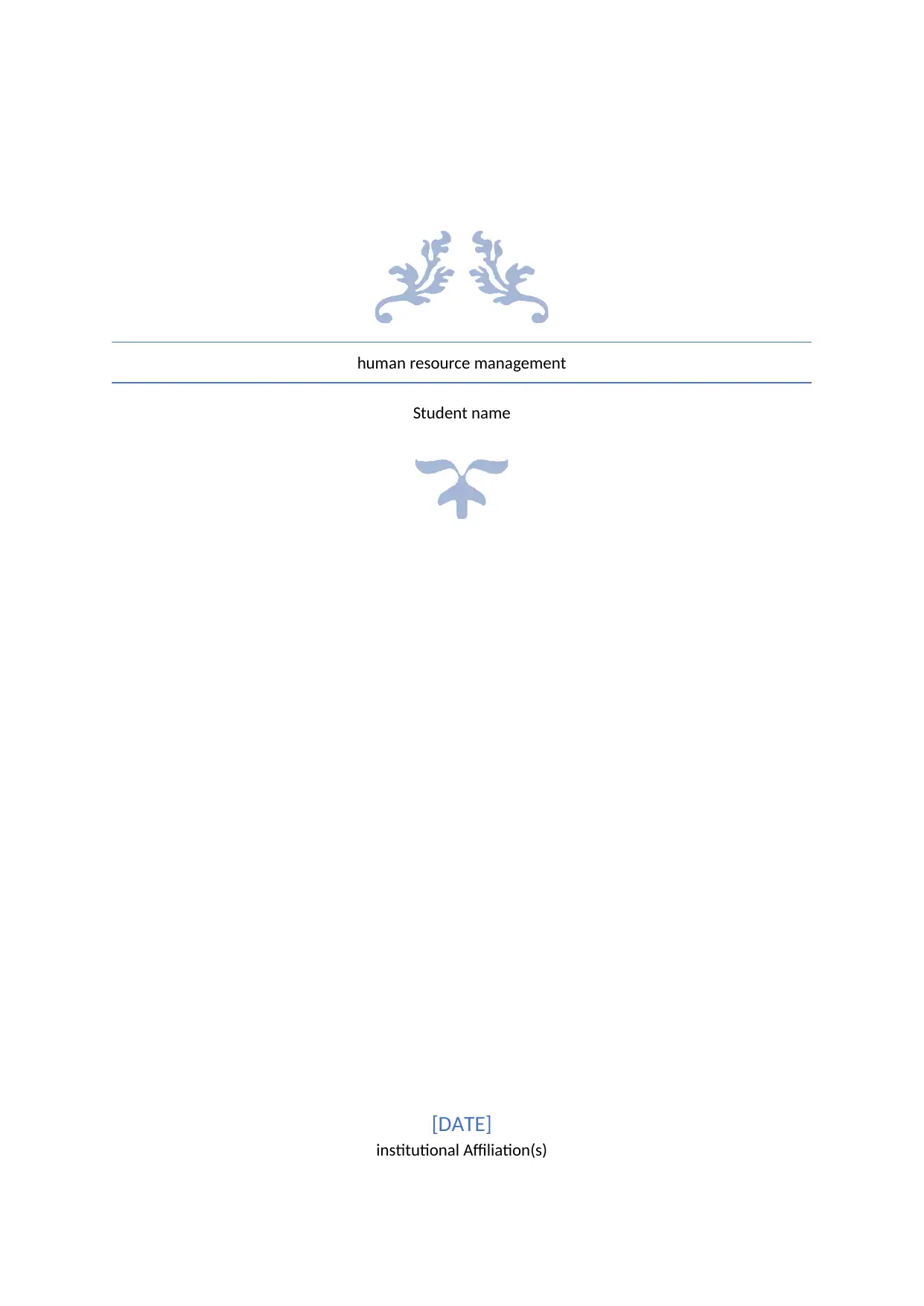
human resource management
Student name
[DATE]
institutional Affiliation(s)
Student name
[DATE]
institutional Affiliation(s)
Secure Best Marks with AI Grader
Need help grading? Try our AI Grader for instant feedback on your assignments.
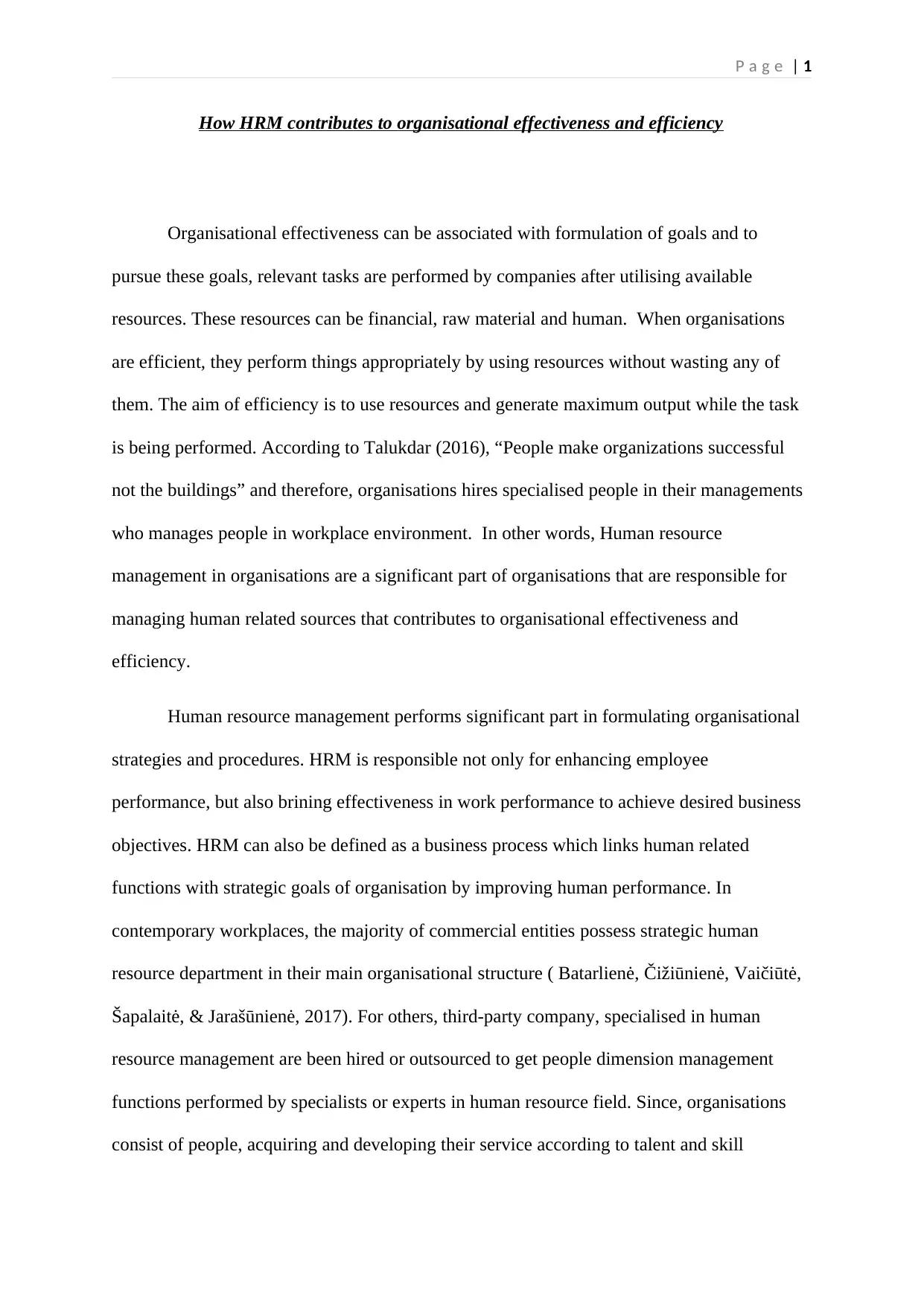
P a g e | 1
How HRM contributes to organisational effectiveness and efficiency
Organisational effectiveness can be associated with formulation of goals and to
pursue these goals, relevant tasks are performed by companies after utilising available
resources. These resources can be financial, raw material and human. When organisations
are efficient, they perform things appropriately by using resources without wasting any of
them. The aim of efficiency is to use resources and generate maximum output while the task
is being performed. According to Talukdar (2016), “People make organizations successful
not the buildings” and therefore, organisations hires specialised people in their managements
who manages people in workplace environment. In other words, Human resource
management in organisations are a significant part of organisations that are responsible for
managing human related sources that contributes to organisational effectiveness and
efficiency.
Human resource management performs significant part in formulating organisational
strategies and procedures. HRM is responsible not only for enhancing employee
performance, but also brining effectiveness in work performance to achieve desired business
objectives. HRM can also be defined as a business process which links human related
functions with strategic goals of organisation by improving human performance. In
contemporary workplaces, the majority of commercial entities possess strategic human
resource department in their main organisational structure ( Batarlienė, Čižiūnienė, Vaičiūtė,
Šapalaitė, & Jarašūnienė, 2017). For others, third-party company, specialised in human
resource management are been hired or outsourced to get people dimension management
functions performed by specialists or experts in human resource field. Since, organisations
consist of people, acquiring and developing their service according to talent and skill
How HRM contributes to organisational effectiveness and efficiency
Organisational effectiveness can be associated with formulation of goals and to
pursue these goals, relevant tasks are performed by companies after utilising available
resources. These resources can be financial, raw material and human. When organisations
are efficient, they perform things appropriately by using resources without wasting any of
them. The aim of efficiency is to use resources and generate maximum output while the task
is being performed. According to Talukdar (2016), “People make organizations successful
not the buildings” and therefore, organisations hires specialised people in their managements
who manages people in workplace environment. In other words, Human resource
management in organisations are a significant part of organisations that are responsible for
managing human related sources that contributes to organisational effectiveness and
efficiency.
Human resource management performs significant part in formulating organisational
strategies and procedures. HRM is responsible not only for enhancing employee
performance, but also brining effectiveness in work performance to achieve desired business
objectives. HRM can also be defined as a business process which links human related
functions with strategic goals of organisation by improving human performance. In
contemporary workplaces, the majority of commercial entities possess strategic human
resource department in their main organisational structure ( Batarlienė, Čižiūnienė, Vaičiūtė,
Šapalaitė, & Jarašūnienė, 2017). For others, third-party company, specialised in human
resource management are been hired or outsourced to get people dimension management
functions performed by specialists or experts in human resource field. Since, organisations
consist of people, acquiring and developing their service according to talent and skill
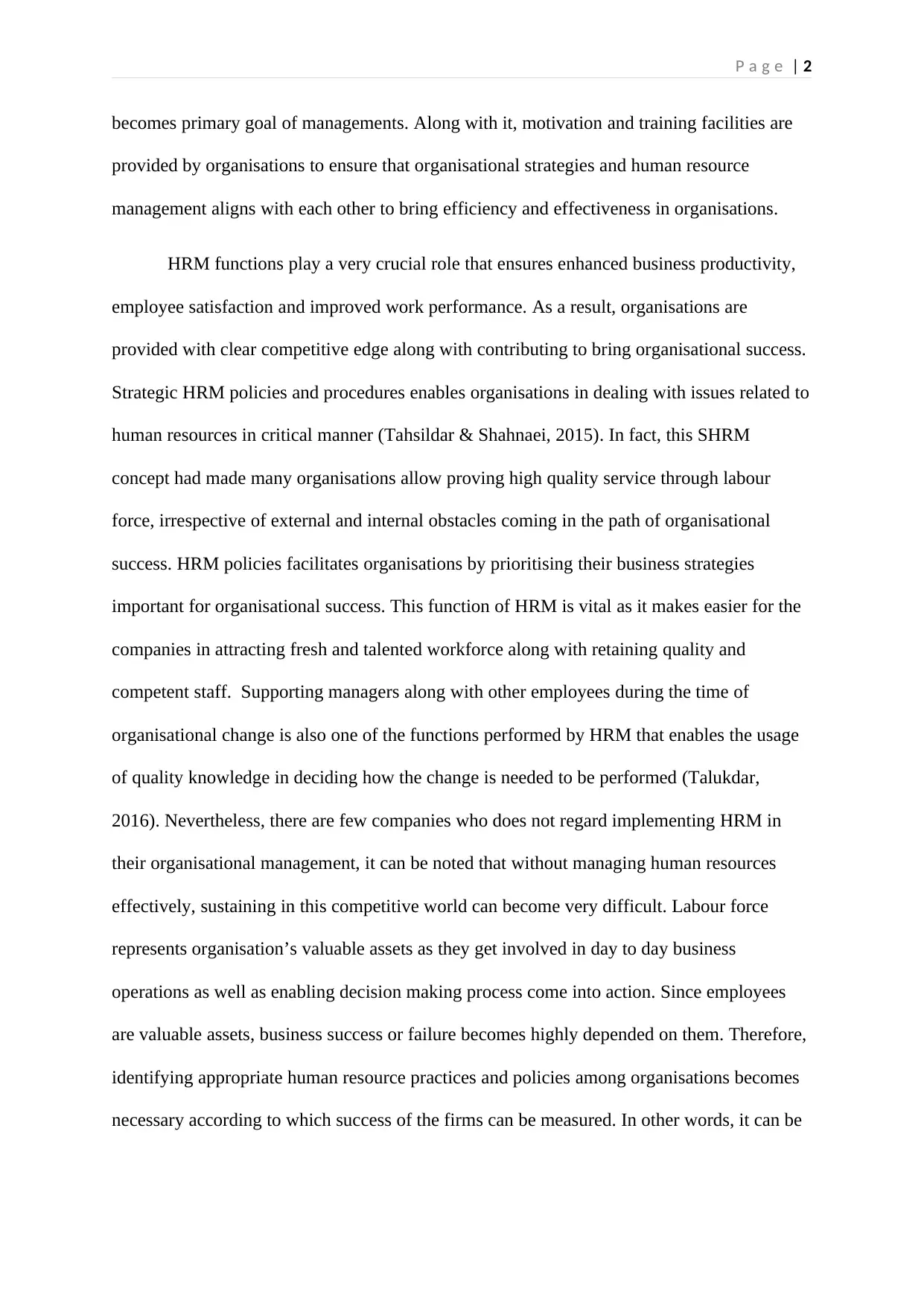
P a g e | 2
becomes primary goal of managements. Along with it, motivation and training facilities are
provided by organisations to ensure that organisational strategies and human resource
management aligns with each other to bring efficiency and effectiveness in organisations.
HRM functions play a very crucial role that ensures enhanced business productivity,
employee satisfaction and improved work performance. As a result, organisations are
provided with clear competitive edge along with contributing to bring organisational success.
Strategic HRM policies and procedures enables organisations in dealing with issues related to
human resources in critical manner (Tahsildar & Shahnaei, 2015). In fact, this SHRM
concept had made many organisations allow proving high quality service through labour
force, irrespective of external and internal obstacles coming in the path of organisational
success. HRM policies facilitates organisations by prioritising their business strategies
important for organisational success. This function of HRM is vital as it makes easier for the
companies in attracting fresh and talented workforce along with retaining quality and
competent staff. Supporting managers along with other employees during the time of
organisational change is also one of the functions performed by HRM that enables the usage
of quality knowledge in deciding how the change is needed to be performed (Talukdar,
2016). Nevertheless, there are few companies who does not regard implementing HRM in
their organisational management, it can be noted that without managing human resources
effectively, sustaining in this competitive world can become very difficult. Labour force
represents organisation’s valuable assets as they get involved in day to day business
operations as well as enabling decision making process come into action. Since employees
are valuable assets, business success or failure becomes highly depended on them. Therefore,
identifying appropriate human resource practices and policies among organisations becomes
necessary according to which success of the firms can be measured. In other words, it can be
becomes primary goal of managements. Along with it, motivation and training facilities are
provided by organisations to ensure that organisational strategies and human resource
management aligns with each other to bring efficiency and effectiveness in organisations.
HRM functions play a very crucial role that ensures enhanced business productivity,
employee satisfaction and improved work performance. As a result, organisations are
provided with clear competitive edge along with contributing to bring organisational success.
Strategic HRM policies and procedures enables organisations in dealing with issues related to
human resources in critical manner (Tahsildar & Shahnaei, 2015). In fact, this SHRM
concept had made many organisations allow proving high quality service through labour
force, irrespective of external and internal obstacles coming in the path of organisational
success. HRM policies facilitates organisations by prioritising their business strategies
important for organisational success. This function of HRM is vital as it makes easier for the
companies in attracting fresh and talented workforce along with retaining quality and
competent staff. Supporting managers along with other employees during the time of
organisational change is also one of the functions performed by HRM that enables the usage
of quality knowledge in deciding how the change is needed to be performed (Talukdar,
2016). Nevertheless, there are few companies who does not regard implementing HRM in
their organisational management, it can be noted that without managing human resources
effectively, sustaining in this competitive world can become very difficult. Labour force
represents organisation’s valuable assets as they get involved in day to day business
operations as well as enabling decision making process come into action. Since employees
are valuable assets, business success or failure becomes highly depended on them. Therefore,
identifying appropriate human resource practices and policies among organisations becomes
necessary according to which success of the firms can be measured. In other words, it can be
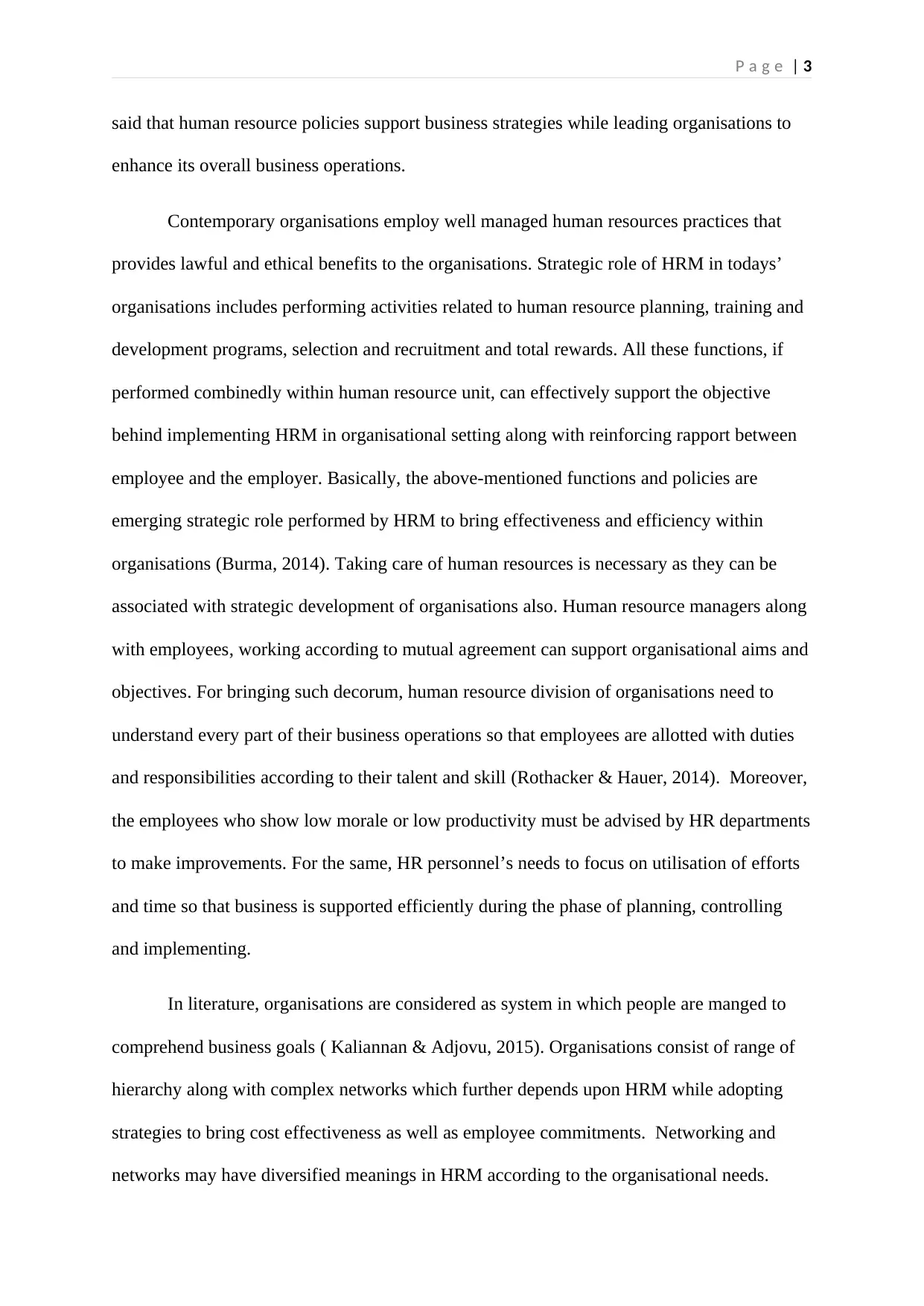
P a g e | 3
said that human resource policies support business strategies while leading organisations to
enhance its overall business operations.
Contemporary organisations employ well managed human resources practices that
provides lawful and ethical benefits to the organisations. Strategic role of HRM in todays’
organisations includes performing activities related to human resource planning, training and
development programs, selection and recruitment and total rewards. All these functions, if
performed combinedly within human resource unit, can effectively support the objective
behind implementing HRM in organisational setting along with reinforcing rapport between
employee and the employer. Basically, the above-mentioned functions and policies are
emerging strategic role performed by HRM to bring effectiveness and efficiency within
organisations (Burma, 2014). Taking care of human resources is necessary as they can be
associated with strategic development of organisations also. Human resource managers along
with employees, working according to mutual agreement can support organisational aims and
objectives. For bringing such decorum, human resource division of organisations need to
understand every part of their business operations so that employees are allotted with duties
and responsibilities according to their talent and skill (Rothacker & Hauer, 2014). Moreover,
the employees who show low morale or low productivity must be advised by HR departments
to make improvements. For the same, HR personnel’s needs to focus on utilisation of efforts
and time so that business is supported efficiently during the phase of planning, controlling
and implementing.
In literature, organisations are considered as system in which people are manged to
comprehend business goals ( Kaliannan & Adjovu, 2015). Organisations consist of range of
hierarchy along with complex networks which further depends upon HRM while adopting
strategies to bring cost effectiveness as well as employee commitments. Networking and
networks may have diversified meanings in HRM according to the organisational needs.
said that human resource policies support business strategies while leading organisations to
enhance its overall business operations.
Contemporary organisations employ well managed human resources practices that
provides lawful and ethical benefits to the organisations. Strategic role of HRM in todays’
organisations includes performing activities related to human resource planning, training and
development programs, selection and recruitment and total rewards. All these functions, if
performed combinedly within human resource unit, can effectively support the objective
behind implementing HRM in organisational setting along with reinforcing rapport between
employee and the employer. Basically, the above-mentioned functions and policies are
emerging strategic role performed by HRM to bring effectiveness and efficiency within
organisations (Burma, 2014). Taking care of human resources is necessary as they can be
associated with strategic development of organisations also. Human resource managers along
with employees, working according to mutual agreement can support organisational aims and
objectives. For bringing such decorum, human resource division of organisations need to
understand every part of their business operations so that employees are allotted with duties
and responsibilities according to their talent and skill (Rothacker & Hauer, 2014). Moreover,
the employees who show low morale or low productivity must be advised by HR departments
to make improvements. For the same, HR personnel’s needs to focus on utilisation of efforts
and time so that business is supported efficiently during the phase of planning, controlling
and implementing.
In literature, organisations are considered as system in which people are manged to
comprehend business goals ( Kaliannan & Adjovu, 2015). Organisations consist of range of
hierarchy along with complex networks which further depends upon HRM while adopting
strategies to bring cost effectiveness as well as employee commitments. Networking and
networks may have diversified meanings in HRM according to the organisational needs.
Secure Best Marks with AI Grader
Need help grading? Try our AI Grader for instant feedback on your assignments.
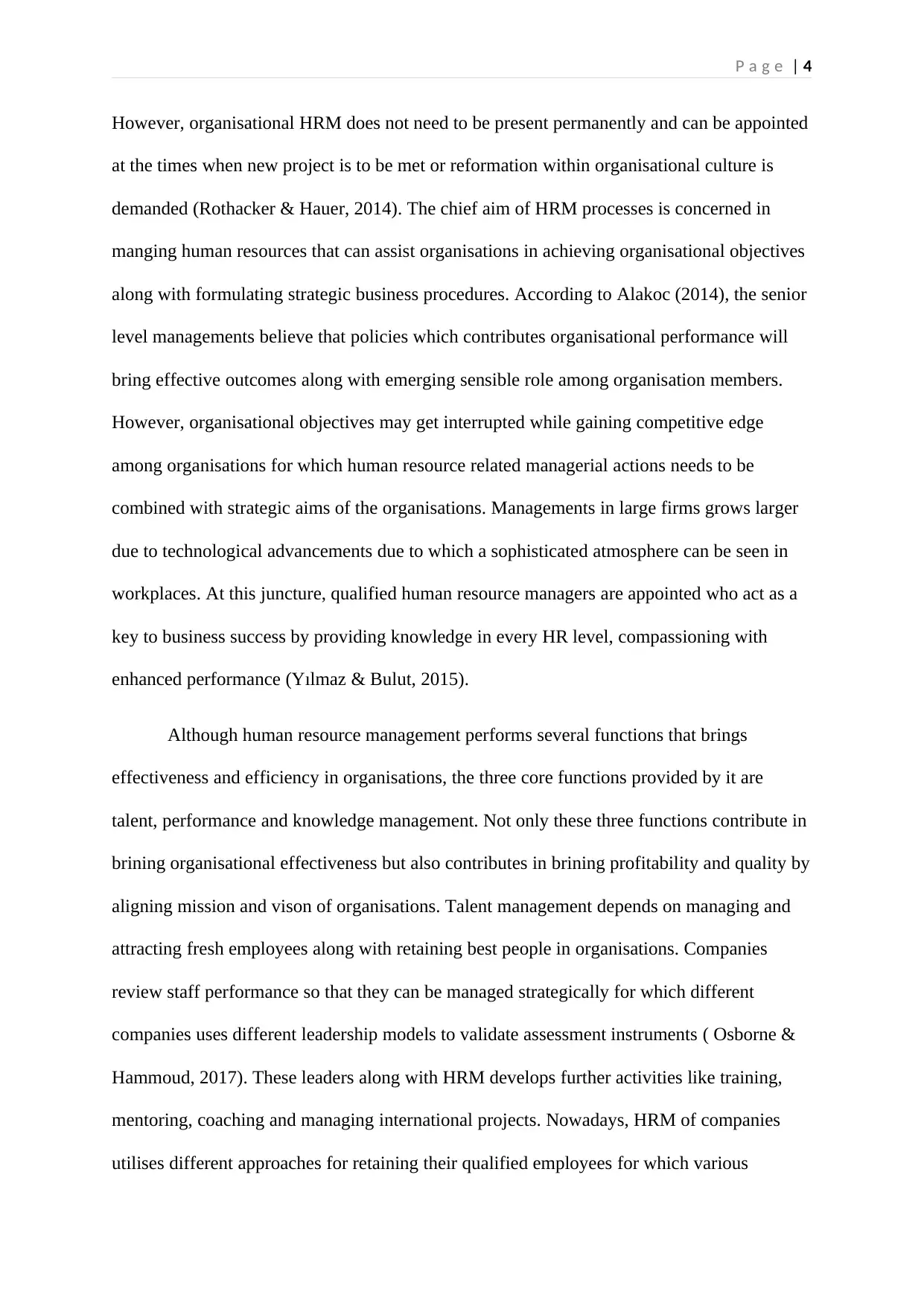
P a g e | 4
However, organisational HRM does not need to be present permanently and can be appointed
at the times when new project is to be met or reformation within organisational culture is
demanded (Rothacker & Hauer, 2014). The chief aim of HRM processes is concerned in
manging human resources that can assist organisations in achieving organisational objectives
along with formulating strategic business procedures. According to Alakoc (2014), the senior
level managements believe that policies which contributes organisational performance will
bring effective outcomes along with emerging sensible role among organisation members.
However, organisational objectives may get interrupted while gaining competitive edge
among organisations for which human resource related managerial actions needs to be
combined with strategic aims of the organisations. Managements in large firms grows larger
due to technological advancements due to which a sophisticated atmosphere can be seen in
workplaces. At this juncture, qualified human resource managers are appointed who act as a
key to business success by providing knowledge in every HR level, compassioning with
enhanced performance (Yılmaz & Bulut, 2015).
Although human resource management performs several functions that brings
effectiveness and efficiency in organisations, the three core functions provided by it are
talent, performance and knowledge management. Not only these three functions contribute in
brining organisational effectiveness but also contributes in brining profitability and quality by
aligning mission and vison of organisations. Talent management depends on managing and
attracting fresh employees along with retaining best people in organisations. Companies
review staff performance so that they can be managed strategically for which different
companies uses different leadership models to validate assessment instruments ( Osborne &
Hammoud, 2017). These leaders along with HRM develops further activities like training,
mentoring, coaching and managing international projects. Nowadays, HRM of companies
utilises different approaches for retaining their qualified employees for which various
However, organisational HRM does not need to be present permanently and can be appointed
at the times when new project is to be met or reformation within organisational culture is
demanded (Rothacker & Hauer, 2014). The chief aim of HRM processes is concerned in
manging human resources that can assist organisations in achieving organisational objectives
along with formulating strategic business procedures. According to Alakoc (2014), the senior
level managements believe that policies which contributes organisational performance will
bring effective outcomes along with emerging sensible role among organisation members.
However, organisational objectives may get interrupted while gaining competitive edge
among organisations for which human resource related managerial actions needs to be
combined with strategic aims of the organisations. Managements in large firms grows larger
due to technological advancements due to which a sophisticated atmosphere can be seen in
workplaces. At this juncture, qualified human resource managers are appointed who act as a
key to business success by providing knowledge in every HR level, compassioning with
enhanced performance (Yılmaz & Bulut, 2015).
Although human resource management performs several functions that brings
effectiveness and efficiency in organisations, the three core functions provided by it are
talent, performance and knowledge management. Not only these three functions contribute in
brining organisational effectiveness but also contributes in brining profitability and quality by
aligning mission and vison of organisations. Talent management depends on managing and
attracting fresh employees along with retaining best people in organisations. Companies
review staff performance so that they can be managed strategically for which different
companies uses different leadership models to validate assessment instruments ( Osborne &
Hammoud, 2017). These leaders along with HRM develops further activities like training,
mentoring, coaching and managing international projects. Nowadays, HRM of companies
utilises different approaches for retaining their qualified employees for which various
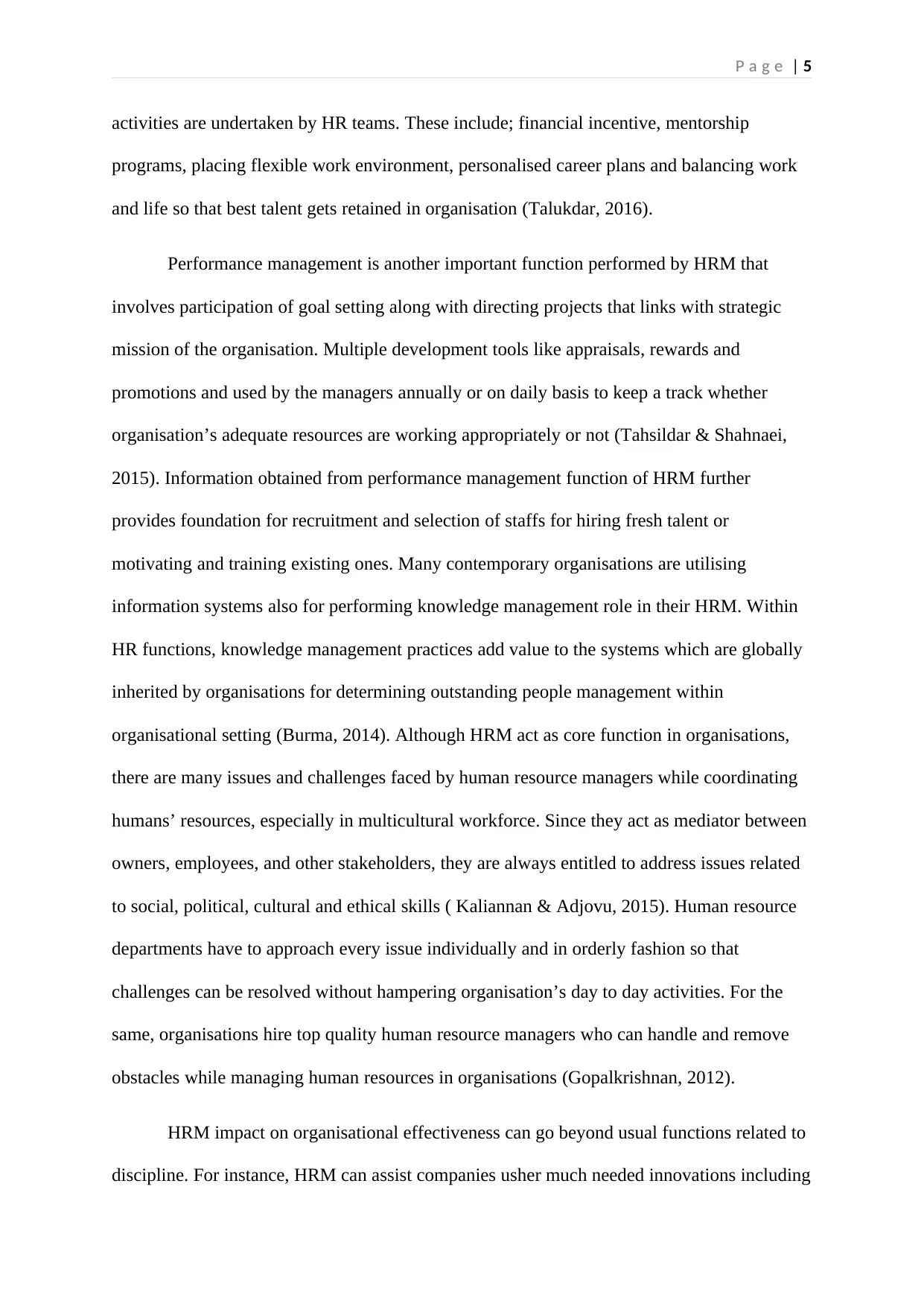
P a g e | 5
activities are undertaken by HR teams. These include; financial incentive, mentorship
programs, placing flexible work environment, personalised career plans and balancing work
and life so that best talent gets retained in organisation (Talukdar, 2016).
Performance management is another important function performed by HRM that
involves participation of goal setting along with directing projects that links with strategic
mission of the organisation. Multiple development tools like appraisals, rewards and
promotions and used by the managers annually or on daily basis to keep a track whether
organisation’s adequate resources are working appropriately or not (Tahsildar & Shahnaei,
2015). Information obtained from performance management function of HRM further
provides foundation for recruitment and selection of staffs for hiring fresh talent or
motivating and training existing ones. Many contemporary organisations are utilising
information systems also for performing knowledge management role in their HRM. Within
HR functions, knowledge management practices add value to the systems which are globally
inherited by organisations for determining outstanding people management within
organisational setting (Burma, 2014). Although HRM act as core function in organisations,
there are many issues and challenges faced by human resource managers while coordinating
humans’ resources, especially in multicultural workforce. Since they act as mediator between
owners, employees, and other stakeholders, they are always entitled to address issues related
to social, political, cultural and ethical skills ( Kaliannan & Adjovu, 2015). Human resource
departments have to approach every issue individually and in orderly fashion so that
challenges can be resolved without hampering organisation’s day to day activities. For the
same, organisations hire top quality human resource managers who can handle and remove
obstacles while managing human resources in organisations (Gopalkrishnan, 2012).
HRM impact on organisational effectiveness can go beyond usual functions related to
discipline. For instance, HRM can assist companies usher much needed innovations including
activities are undertaken by HR teams. These include; financial incentive, mentorship
programs, placing flexible work environment, personalised career plans and balancing work
and life so that best talent gets retained in organisation (Talukdar, 2016).
Performance management is another important function performed by HRM that
involves participation of goal setting along with directing projects that links with strategic
mission of the organisation. Multiple development tools like appraisals, rewards and
promotions and used by the managers annually or on daily basis to keep a track whether
organisation’s adequate resources are working appropriately or not (Tahsildar & Shahnaei,
2015). Information obtained from performance management function of HRM further
provides foundation for recruitment and selection of staffs for hiring fresh talent or
motivating and training existing ones. Many contemporary organisations are utilising
information systems also for performing knowledge management role in their HRM. Within
HR functions, knowledge management practices add value to the systems which are globally
inherited by organisations for determining outstanding people management within
organisational setting (Burma, 2014). Although HRM act as core function in organisations,
there are many issues and challenges faced by human resource managers while coordinating
humans’ resources, especially in multicultural workforce. Since they act as mediator between
owners, employees, and other stakeholders, they are always entitled to address issues related
to social, political, cultural and ethical skills ( Kaliannan & Adjovu, 2015). Human resource
departments have to approach every issue individually and in orderly fashion so that
challenges can be resolved without hampering organisation’s day to day activities. For the
same, organisations hire top quality human resource managers who can handle and remove
obstacles while managing human resources in organisations (Gopalkrishnan, 2012).
HRM impact on organisational effectiveness can go beyond usual functions related to
discipline. For instance, HRM can assist companies usher much needed innovations including
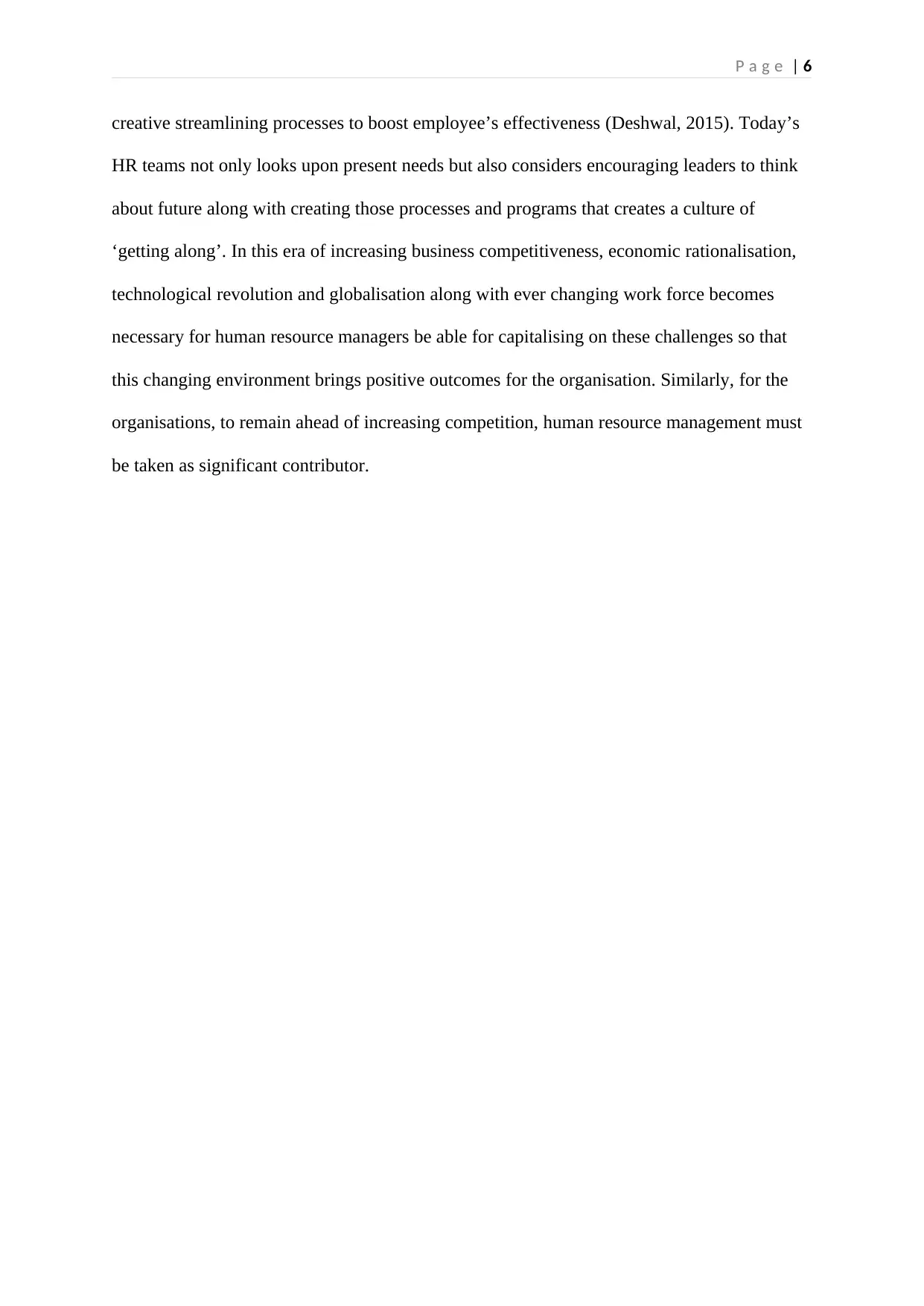
P a g e | 6
creative streamlining processes to boost employee’s effectiveness (Deshwal, 2015). Today’s
HR teams not only looks upon present needs but also considers encouraging leaders to think
about future along with creating those processes and programs that creates a culture of
‘getting along’. In this era of increasing business competitiveness, economic rationalisation,
technological revolution and globalisation along with ever changing work force becomes
necessary for human resource managers be able for capitalising on these challenges so that
this changing environment brings positive outcomes for the organisation. Similarly, for the
organisations, to remain ahead of increasing competition, human resource management must
be taken as significant contributor.
creative streamlining processes to boost employee’s effectiveness (Deshwal, 2015). Today’s
HR teams not only looks upon present needs but also considers encouraging leaders to think
about future along with creating those processes and programs that creates a culture of
‘getting along’. In this era of increasing business competitiveness, economic rationalisation,
technological revolution and globalisation along with ever changing work force becomes
necessary for human resource managers be able for capitalising on these challenges so that
this changing environment brings positive outcomes for the organisation. Similarly, for the
organisations, to remain ahead of increasing competition, human resource management must
be taken as significant contributor.
Paraphrase This Document
Need a fresh take? Get an instant paraphrase of this document with our AI Paraphraser
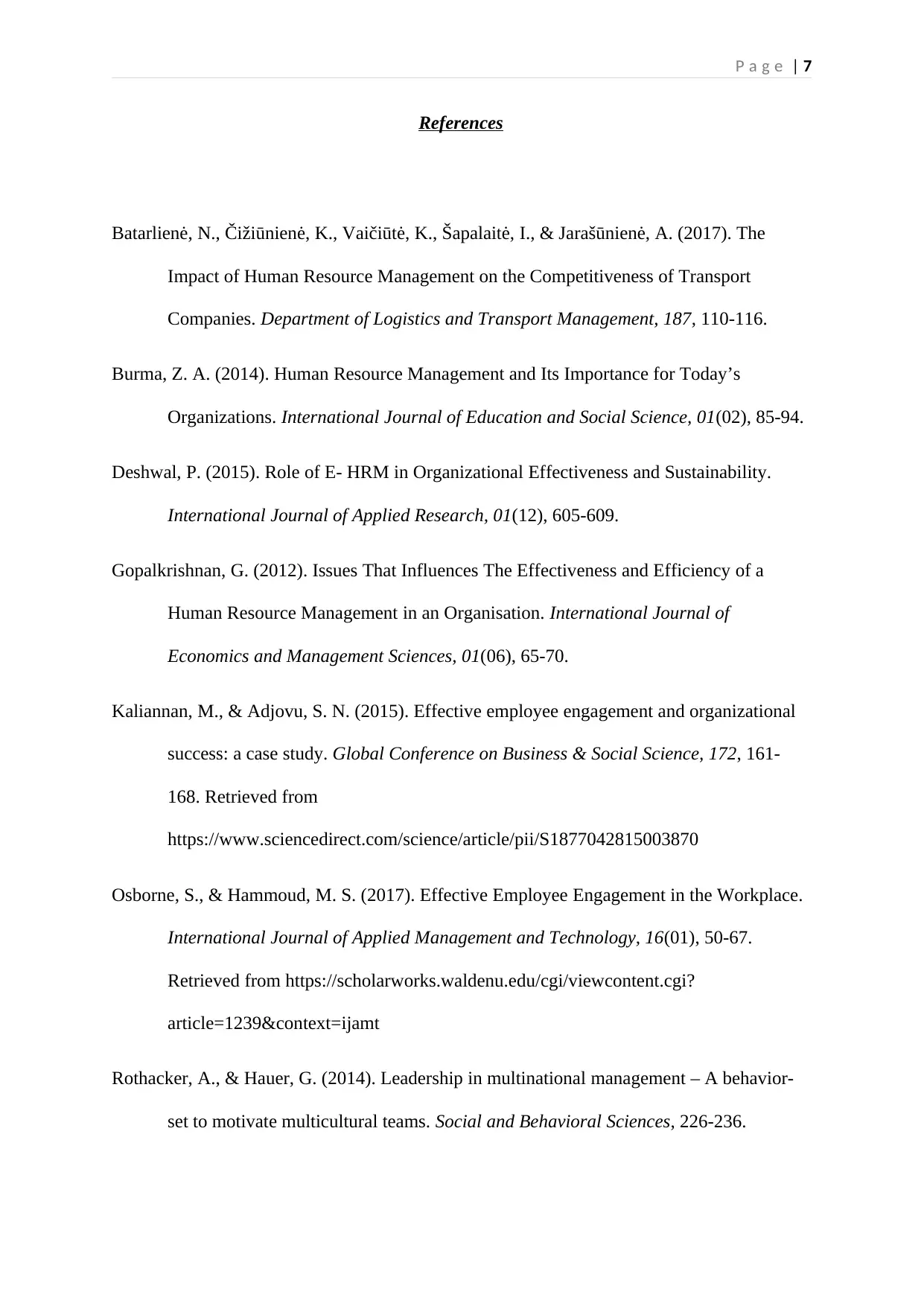
P a g e | 7
References
Batarlienė, N., Čižiūnienė, K., Vaičiūtė, K., Šapalaitė, I., & Jarašūnienė, A. (2017). The
Impact of Human Resource Management on the Competitiveness of Transport
Companies. Department of Logistics and Transport Management, 187, 110-116.
Burma, Z. A. (2014). Human Resource Management and Its Importance for Today’s
Organizations. International Journal of Education and Social Science, 01(02), 85-94.
Deshwal, P. (2015). Role of E- HRM in Organizational Effectiveness and Sustainability.
International Journal of Applied Research, 01(12), 605-609.
Gopalkrishnan, G. (2012). Issues That Influences The Effectiveness and Efficiency of a
Human Resource Management in an Organisation. International Journal of
Economics and Management Sciences, 01(06), 65-70.
Kaliannan, M., & Adjovu, S. N. (2015). Effective employee engagement and organizational
success: a case study. Global Conference on Business & Social Science, 172, 161-
168. Retrieved from
https://www.sciencedirect.com/science/article/pii/S1877042815003870
Osborne, S., & Hammoud, M. S. (2017). Effective Employee Engagement in the Workplace.
International Journal of Applied Management and Technology, 16(01), 50-67.
Retrieved from https://scholarworks.waldenu.edu/cgi/viewcontent.cgi?
article=1239&context=ijamt
Rothacker, A., & Hauer, G. (2014). Leadership in multinational management – A behavior-
set to motivate multicultural teams. Social and Behavioral Sciences, 226-236.
References
Batarlienė, N., Čižiūnienė, K., Vaičiūtė, K., Šapalaitė, I., & Jarašūnienė, A. (2017). The
Impact of Human Resource Management on the Competitiveness of Transport
Companies. Department of Logistics and Transport Management, 187, 110-116.
Burma, Z. A. (2014). Human Resource Management and Its Importance for Today’s
Organizations. International Journal of Education and Social Science, 01(02), 85-94.
Deshwal, P. (2015). Role of E- HRM in Organizational Effectiveness and Sustainability.
International Journal of Applied Research, 01(12), 605-609.
Gopalkrishnan, G. (2012). Issues That Influences The Effectiveness and Efficiency of a
Human Resource Management in an Organisation. International Journal of
Economics and Management Sciences, 01(06), 65-70.
Kaliannan, M., & Adjovu, S. N. (2015). Effective employee engagement and organizational
success: a case study. Global Conference on Business & Social Science, 172, 161-
168. Retrieved from
https://www.sciencedirect.com/science/article/pii/S1877042815003870
Osborne, S., & Hammoud, M. S. (2017). Effective Employee Engagement in the Workplace.
International Journal of Applied Management and Technology, 16(01), 50-67.
Retrieved from https://scholarworks.waldenu.edu/cgi/viewcontent.cgi?
article=1239&context=ijamt
Rothacker, A., & Hauer, G. (2014). Leadership in multinational management – A behavior-
set to motivate multicultural teams. Social and Behavioral Sciences, 226-236.
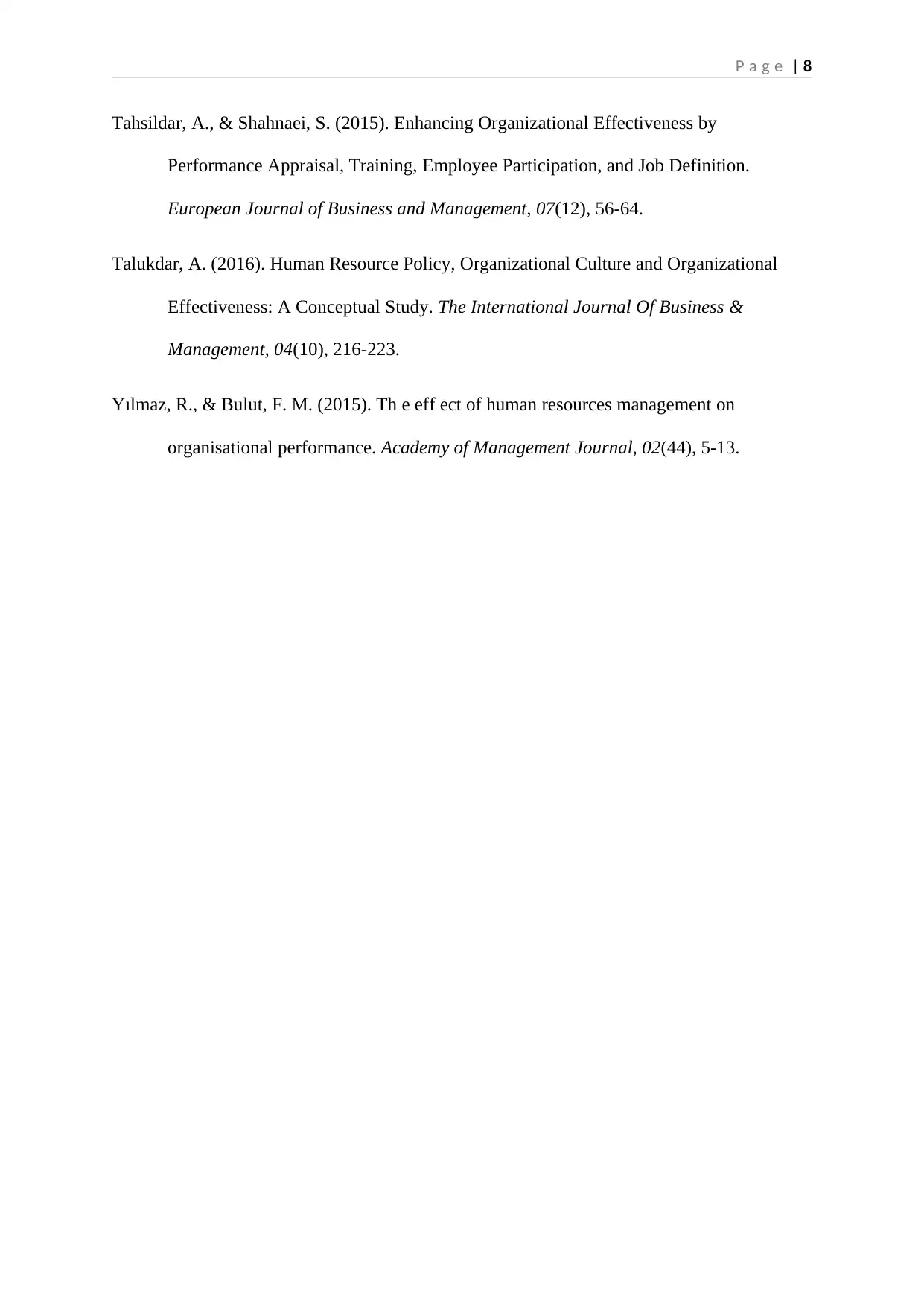
P a g e | 8
Tahsildar, A., & Shahnaei, S. (2015). Enhancing Organizational Effectiveness by
Performance Appraisal, Training, Employee Participation, and Job Definition.
European Journal of Business and Management, 07(12), 56-64.
Talukdar, A. (2016). Human Resource Policy, Organizational Culture and Organizational
Effectiveness: A Conceptual Study. The International Journal Of Business &
Management, 04(10), 216-223.
Yılmaz, R., & Bulut, F. M. (2015). Th e eff ect of human resources management on
organisational performance. Academy of Management Journal, 02(44), 5-13.
Tahsildar, A., & Shahnaei, S. (2015). Enhancing Organizational Effectiveness by
Performance Appraisal, Training, Employee Participation, and Job Definition.
European Journal of Business and Management, 07(12), 56-64.
Talukdar, A. (2016). Human Resource Policy, Organizational Culture and Organizational
Effectiveness: A Conceptual Study. The International Journal Of Business &
Management, 04(10), 216-223.
Yılmaz, R., & Bulut, F. M. (2015). Th e eff ect of human resources management on
organisational performance. Academy of Management Journal, 02(44), 5-13.
1 out of 9
Related Documents
Your All-in-One AI-Powered Toolkit for Academic Success.
+13062052269
info@desklib.com
Available 24*7 on WhatsApp / Email
![[object Object]](/_next/static/media/star-bottom.7253800d.svg)
Unlock your academic potential
© 2024 | Zucol Services PVT LTD | All rights reserved.




